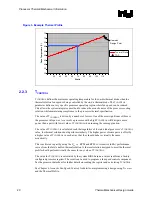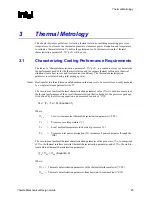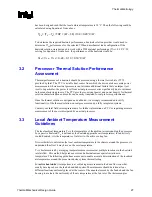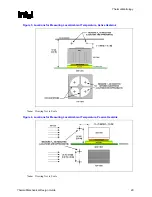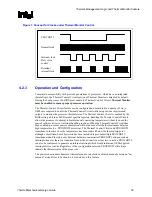
Processor Thermal/Mechanical Information
R
Thermal/Mechanical Design Guide
21
2.3
Heatsink Design Considerations
To remove the heat from the processor, three basic parameters should be considered:
•
The area of the surface on which the heat transfer takes place
. Without any
enhancements, this is the surface of the processor package IHS. One method used to improve
thermal performance is by attaching a heatsink to the IHS. A heatsink can increase the
effective heat transfer surface area by conducting heat out of the IHS and into the
surrounding air through fins attached to the heatsink base.
•
The conduction path from the heat source to the heatsink fins
. Providing a direct
conduction path from the heat source to the heatsink fins and selecting materials with higher
thermal conductivity typically improves heatsink performance. The length, thickness, and
conductivity of the conduction path from the heat source to the fins directly impact the
thermal performance of the heatsink. In particular, the quality of the contact between the
package IHS and the heatsink base has a higher impact on the overall thermal solution
performance as processor cooling requirements become stricter. Thermal interface material
(TIM) is used to fill in the gap between the IHS and the bottom surface of the heatsink, and
thereby improve the overall performance of the stack-up (IHS-TIM-Heatsink). With
extremely poor heatsink interface flatness or roughness, TIM may not adequately fill the gap.
The TIM thermal performance depends on its thermal conductivity as well as the pressure
applied to it. Refer to Section 2.3.4 and Appendix C for further information on TIM and on
bond line management between the IHS and the heatsink base.
•
The heat transfer conditions on the surface on which heat transfer takes place
.
Convective heat transfer occurs between the airflow and the surface exposed to the flow. It is
characterized by the local ambient temperature of the air, T
A
, and the local air velocity over
the surface. The higher the air velocity over the surface, and the cooler the air, the more
efficient is the resulting cooling. The nature of the airflow can also enhance heat transfer via
convection. Turbulent flow can provide improvement over laminar flow. In the case of a
heatsink, the surface exposed to the flow includes in particular the fin faces and the heatsink
base.
Active heatsinks
typically incorporate a fan that helps manage the airflow through the heatsink.
Passive heatsink
solutions require in-depth knowledge of the airflow in the chassis. Typically,
passive heatsinks see lower air speed. These heatsinks are therefore typically larger (and heavier)
than active heatsinks due to the increase in fin surface required to meet a required performance.
As the heatsink fin density (the number of fins in a given cross-section) increases, the resistance
to the airflow increases: it is more likely that the air travels around the heatsink instead of through
it, unless air bypass is carefully managed. Using air-ducting techniques to manage bypass area can
be an effective method for controlling airflow through the heatsink.
Summary of Contents for 640 - Pentium 4 640 3.2GHz 800MHz 2MB Socket 775 CPU
Page 14: ...Introduction R 14 Thermal Mechanical Design Guide ...
Page 38: ...Thermal Management Logic and Thermal Monitor Feature R 38 Thermal Mechanical Design Guide ...
Page 52: ...Intel Thermal Mechanical Reference Design Information R 52 Thermal Mechanical Design Guide ...
Page 60: ...Acoustic Fan Speed Control R 60 Thermal Mechanical Design Guide ...
Page 72: ...Heatsink Clip Load Metrology R 72 Thermal Mechanical Design Guide ...
Page 99: ...Mechanical Drawings R Thermal Mechanical Design Guide 99 Figure 50 Reference Fastener Sheet 1 ...
Page 103: ...Mechanical Drawings R Thermal Mechanical Design Guide 103 Figure 54 Clip Heatsink Assembly ...














